Thanks to ChatGPT and the rapid rise of AI-generated content, we are mere weeks into a brave new world of content marketing. As Canadian novelist and Atlantic writer put it, “welcome to the Big Blur.” We are now unable to definitively know if the content we read was written by the people we follow or artificial intelligence (or some combination of the two).
I predict this new landscape of content marketing will produce two major changes in audiences.
First, audiences will be even more inundated with content across every channel they frequent (since creating content with ChatGPT and similar chatbots has become so easy). The floodgates of AI-generated content have opened.
Second, audiences will be more interested in personalized content, catered directly to them, written and created in the words of the people they actually want to hear from.
According to a study by Epsilon, personalized emails boasted a 29% open rate compared to a 22% open rate for non-personalized emails, with a click-through rate 2.5x higher in the personalized emails.
When it comes to website readers and content consumers, the numbers reveal a stronger case for personalized content. A survey by Janrain found 74% of online consumers get frustrated with websites that feature content that has nothing to do with their interests. HubSpot found personalized calls-to-action had a 42% higher click-through rate than generic ones. A report by Monetate revealed that personalized content can lead to a 20% increase in sales.
The lesson here is simple: personalized content matters, and will matter more in an internet flooded with generic, AI-written content.
Here are five ways to cater your content to your audience to increase engagement, traffic, and overall revenue for your site.
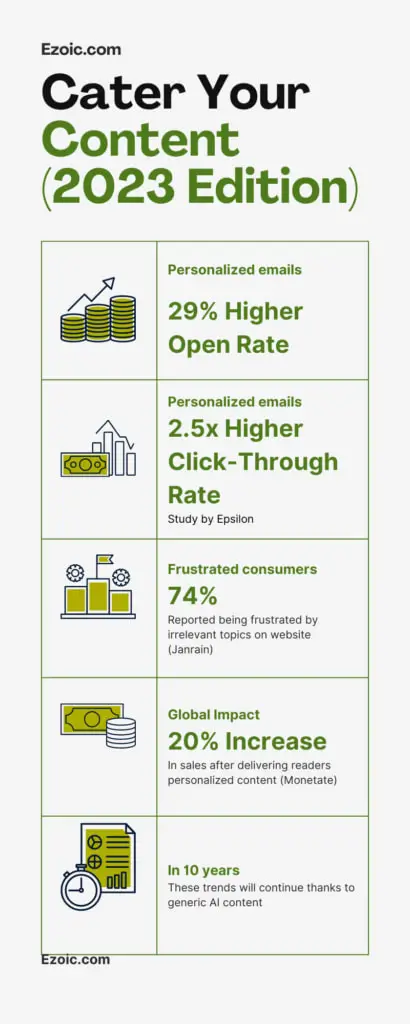
1. Your Content Categories Report in your Ezoic Dashboard
My wife works in HR, and I asked her what the difference was between all those job titles that sounded like just another word for “manager,” like “coordinator,” “director,” “administrator,” etc.
She told me the difference was simple: decision-making. The higher you climb the corporate ladder, the more (and bigger) decisions you need to make on behalf of your team and the company.
When you run a website, you’re in charge of everything. And if you continue to create content about junk that no one cares about, it’s kind of like running a company that creates products no one wants to buy. That kind of company usually ends up bankrupt.
But how do you know what your audience wants? One simple method of measuring this is by using the Content Categories tab in Ezoic’s Big Data Analytics, which you can access here.

This report instantly tells you what topics your audience is most interested in. Many publishers have found this report enlightening, revealing that their audience responds positively to topics the publisher wasn’t even thinking about — and vice versa!
After being a publisher for over ten years and earning a full-time income through millions of views, I learned that there’s a very simple loop that successful publishers follow: ask your audience what they want, give it to them, get more followers, repeat. It all starts with giving your audience what they want.
2. Send Your Readers a Survey and Ask Them Directly
Speaking of asking your audience what they want, stop reading this article and send a message to your audience and ask them what they want.
It sounds silly, but you’d be shocked how few publishers actually take time to research this absolutely crucial data. A study by CXL found that only 40% of marketers say their content marketing is effective, which suggests that the majority of content creators are struggling to create content that resonates with their audience.
You might not have an arsenal of researchers and data analysts at your disposal, but you can secure workable, useful insights into your audience simply by asking them what content they prefer. Here are some sample questions you can ask your audience:
- How did you find out about our blog?
- How often do you visit our blog?
- How long have you been following our blog?
- What type of content do you enjoy reading the most on our blog?
- What type of content would you like to see more of on our blog?
- How often do you share our blog posts on social media?
- What social media platforms do you use the most to engage with our blog?
- Do you have any suggestions for improving our blog content or website design?
- Would you be interested in receiving newsletters or email updates from our blog?
- What other blogs or websites do you follow that cover similar topics to our blog?
- Have you ever purchased a product or service based on a recommendation from our blog?
- How likely are you to engage with our sponsored content or affiliate links?
- Would you be interested in participating in surveys or polls related to our blog content?
- Is there anything else you’d like to share with us about your experience as a reader of our blog?
These kind of questions can reveal key insights into your audience that can and should be the driving factors behind your content decisions — where to post your content, what topics to write about, what products to sell, how often to post, where to find more data, etc.
Ask your audience what they want, and give it to them. I’d recommend putting these questions in a free Google form or survey, then promote it on social media, through email newsletters, blog posts, etc.

3. Simple Market Research and Competitor Analysis
There’s a cookbook called America’s Test Kitchen that was created by a team of dozens of cooks. They made each recipe dozens, and sometimes hundreds of times so they could have extensive, complete, and utter surety on the absolute “best” way to cook popular dishes. You could save years — or decades — trying to find the best way to bake an apple pie or scramble eggs just by reading this book.
Researching your niche’s top competitors provides similar advantages. Odds are, these content creators have been in this space for many years, creating hundreds or thousands of pieces of content. This wealth of data has given them the most complete insights into their industry, and the reason they’re so successful is probably because they know exactly what their audience wants.
If you simply take a look at your competitors, you can see this years-long research on full display: on their social media channels, in their headlines, thumbnails, tweets, books, blog posts, online courses, products, websites, and anywhere else they post.
For instance, if you create content about self-improvement, go on YouTube and type in “self-improvement,” then filter by views. You can instantly see what the highest-performing topics are, and the exact headlines, thumbnails, and scripts your niche’s top influencers have chosen to use.
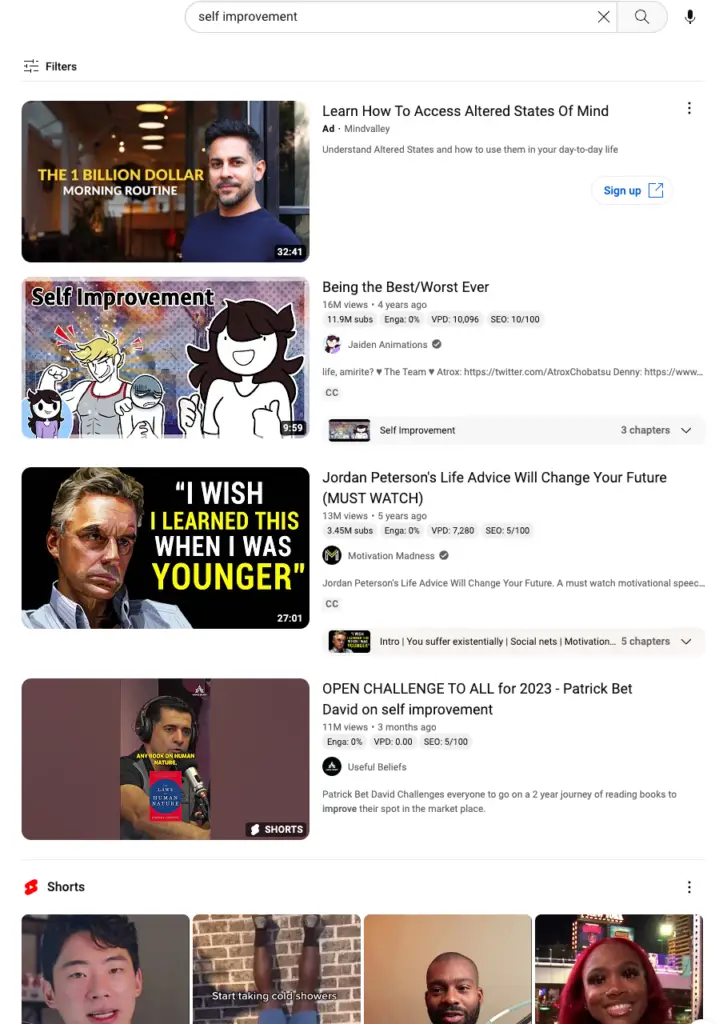
You can do the same thing on Amazon to search for books in your niche, social media channels to search for the highest-performing social media posts, or even just your competitor’s home page right now. Odds are, they are basing these decisions on years of market research, and savvy publishers take note of their competitor’s activity and strategies.
4. SEO Keyword Research Tools
In addition to your own sleuthing and competitor analysis, you can get more concrete data and use SEO keyword tools to see what your audience is searching for and trying to find online.
There are countless SEO tools you can use. Here’s a short of list of some of the best SEO keyword research tools any publisher can use for their site:
- Google Keyword Planner: Google’s free keyword research tool has helped countless publishers practice better SEO and learn more about their audience. It helps you to find the right keywords to target for your blog and gives you information about the search volume, competition, and estimated cost per click of keywords (the higher the cost, the more popular the keyword).
- Ahrefs: This powerful SEO tool provides you with information about the search volume, difficulty level, and potential traffic of keywords. A bit more technical like Google Keyword Planner, Ahrefs is still a massively popular keyword tool.
- SEMrush: This SEO tool specializes in providing keyword research and competitive analysis. You can use it to find the most profitable keywords for your blog, as well as track your competitors’ keyword rankings. Again, they probably know something you don’t — pay attention to what they’re doing.
- Keyword Tool: This tool generates long-tail keyword suggestions based on Google Autocomplete. It provides you with hundreds of relevant keyword suggestions for your blog, based on actual user data who are searching for those topics.
- Moz Keyword Explorer: This tool helps you find the best keywords to target for your blog by providing you with information about the search volume, difficulty level, and organic click-through rate of keywords.
- NicheIQ: Ezoic’s nicheIQ is a great SEO tool for bloggers because it provides AI-driven analysis of a blog’s content, keyword usage, and site structure. It also offers competitor analysis and keyword research features that help bloggers make data-driven decisions to improve search visibility and drive more traffic and revenue.
Any of these keyword research tools will provide critical insights into what your audience is looking for. Used properly, this information can provide unique, powerful insights into connecting with your audience through giving them more personalized, custom content.
5. Ask ChatGPT for Help
Seems like no relevant article about content nowadays can afford to skip over ChatGPT’s abilities and utilities. This case is no different; simply asking ChatGPT for the answers can give you viable data to make content decisions:
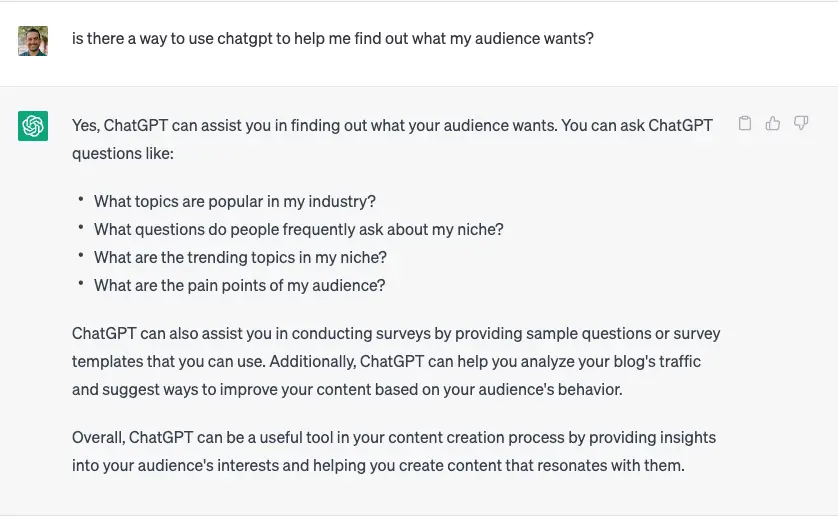
Keep in mind, ChatGPT responses like this will work the best if you give it more specific data to use. For instance, take a look at these two examples. In the first one, I asked ChatGPT what topics to write about for my fictional “fitness blog”:
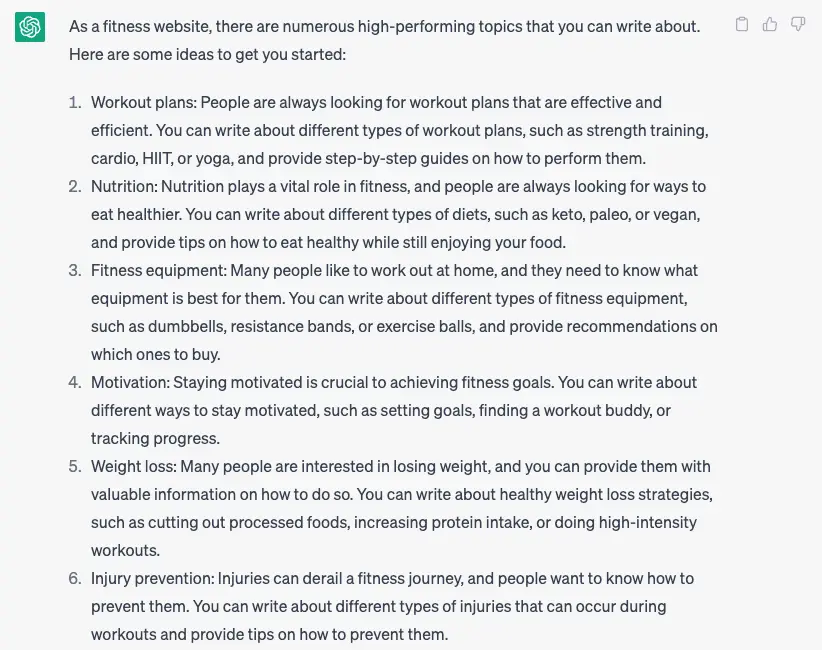
As you can see, this generic content has been done to death and probably won’t move the needle for your site or get your audience much more engaged.
But in the following example, I used a lot of market data for my fictional site, specifying my audience was “I run a weight-loss website targeting new moms under 40 years old with very little free time, what high-performing topics should I write about?”:
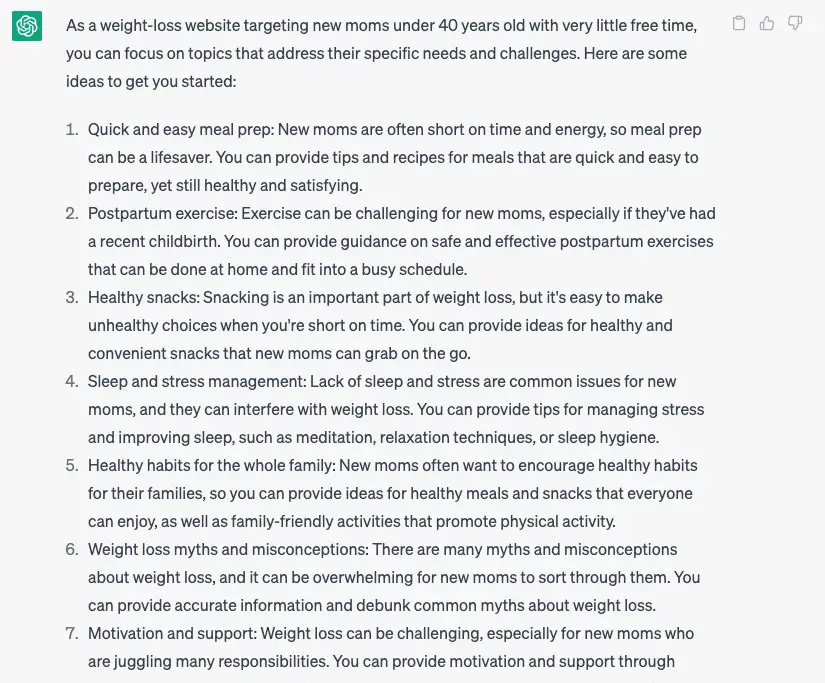
ChatGPT can provide a solid direction for your content (or at the very least, spark some inspiration). You can get more and more specific, weeding your way through ChatGPT responses until you find the most unique and high-performing blog topics for your niche.
In Conclusion
If it was easy, everyone would have successful sites with hyper-engaged audiences. There’s a reason why building a popular site complete with a robust audience is so difficult — and so rewarding for publishers that figure it out.
We live in a unique, rapidly-changing time where AI can generate content faster than humans can blink, where every niche is saturated and every connection matters.
You can bind yourself to your audience and connect with them by giving them personalized, custom content. Find out more about them, and give them what they’re looking for. Enter the feedback loop that all successful publishers are in: ask your audience what they want, give it to them, and attract a bigger audience.


